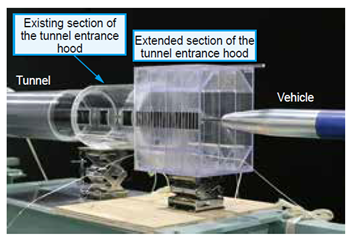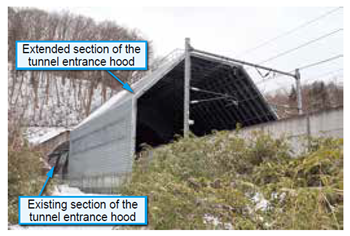19. Two-Step Cross-Sectional Tunnel Entrance Hood
One method to reduce micro-pressure waves emitted from exit of tunnels is the installation of a tunnel entrance hood at the entrance of tunnels. With increasing speeds, extending the tunnel entrance hood is necessary; however, longer extensions lead to higher costs and may be difficult to implement depending on the conditions around the entrance of tunnel. Therefore, we estimated specifications for a more effective tunnel entrance hood extension using acoustic model calculations and verified them through scale model experiments (Figure 1).
As a result, while conventional tunnel entrance hoods typically have a cross-sectional area about 1.5 times that of the main tunnel, increasing the extension section’s cross-sectional area to 2.5 to 3.0 times that of the main tunnel allowed a reduction of the maximum pressure gradient of the compression wavefront to a similar level, even with approximately 15% shorter length than conventional tunnel entrance hoods. This indicates its effectiveness in reducing micro-pressure waves (Figure 2).
Based on these studies, a two-step cross-sectional tunnel entrance hood with an extension section having 2.5 times the cross-sectional area of the main tunnel was installed in a Shinkansen tunnel (Figure 3), and its effectiveness was verified through field measurements. As a result, the maximum micro-pressure wave at the same speed was significantly reduced. At a train speed of 320 km/h, the maximum micro-pressure wave was lower than that at 260 km/h before the tunnel entrance hood extension, confirming that the increase in train speed does not worsen the current conditions
(Figure 4).
Other Contents
- 19. Two-Step Cross-Sectional Tunnel Entrance Hood
- 20. Method for Detailed Prediction of Contribution of Each Noise Source on Wayside Noise Generated by Shinkansen Vehicles
- 21. Integrated Control Method for Railway Energy Storage Systems Enabling the Use of Renewable Energy
- 22. Development and Commercial Operation Demonstration of High-capacity Superconducting Feeding for Urban Commuter Lines
- 23. Safety Assessment of Hydrogen Fuel Cell Multiple Units
- 19. Two-Step Cross-Sectional Tunnel Entrance Hood
- 20. Method for Detailed Prediction of Contribution of Each Noise Source on Wayside Noise Generated by Shinkansen Vehicles
- 21. Integrated Control Method for Railway Energy Storage Systems Enabling the Use of Renewable Energy
- 22. Development and Commercial Operation Demonstration of High-capacity Superconducting Feeding for Urban Commuter Lines
- 23. Safety Assessment of Hydrogen Fuel Cell Multiple Units




